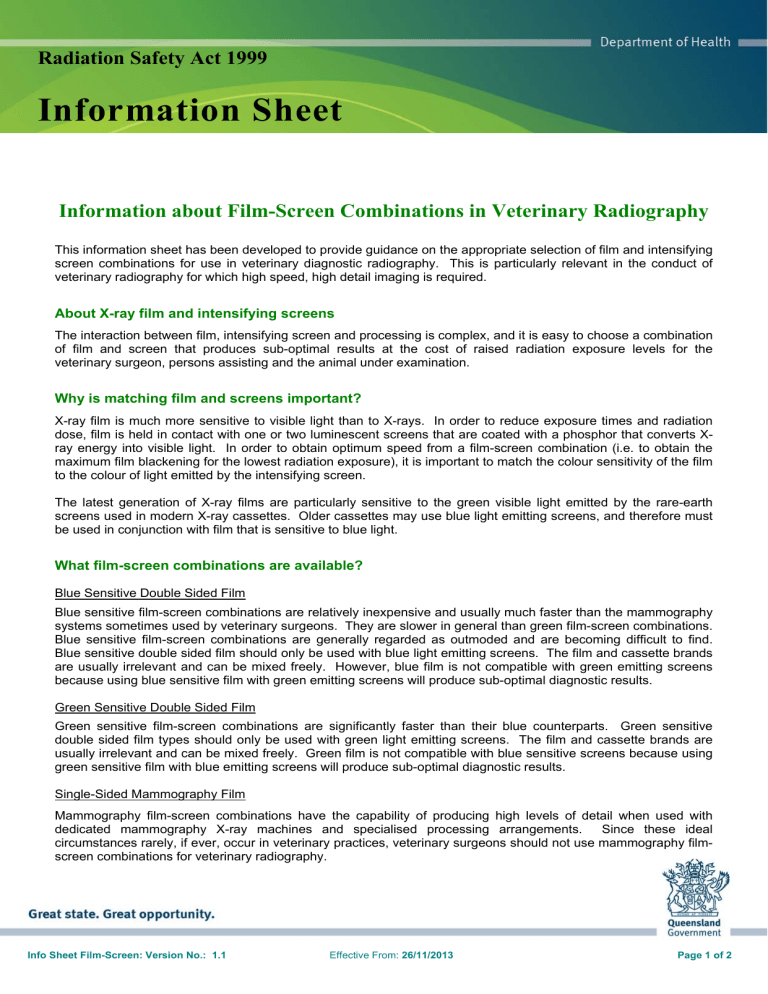Film-Screen Combinations in Veterinary Radiography

Radiation Safety Act 1999
Information Sheet
Information about Film-Screen Combinations in Veterinary Radiography
This information sheet has been developed to provide guidance on the appropriate selection of film and intensifying screen combinations for use in veterinary diagnostic radiography. This is particularly relevant in the conduct of veterinary radiography for which high speed, high detail imaging is required.
About X-ray film and intensifying screens
The interaction between film, intensifying screen and processing is complex, and it is easy to choose a combination of film and screen that produces sub-optimal results at the cost of raised radiation exposure levels for the veterinary surgeon, persons assisting and the animal under examination.
Why is matching film and screens important?
X-ray film is much more sensitive to visible light than to X-rays. In order to reduce exposure times and radiation dose, film is held in contact with one or two luminescent screens that are coated with a phosphor that converts Xray energy into visible light. In order to obtain optimum speed from a film-screen combination (i.e. to obtain the maximum film blackening for the lowest radiation exposure), it is important to match the colour sensitivity of the film to the colour of light emitted by the intensifying screen.
The latest generation of X-ray films are particularly sensitive to the green visible light emitted by the rare-earth screens used in modern X-ray cassettes. Older cassettes may use blue light emitting screens, and therefore must be used in conjunction with film that is sensitive to blue light.
What film-screen combinations are available?
Blue Sensitive Double Sided Film
Blue sensitive film-screen combinations are relatively inexpensive and usually much faster than the mammography systems sometimes used by veterinary surgeons. They are slower in general than green film-screen combinations.
Blue sensitive film-screen combinations are generally regarded as outmoded and are becoming difficult to find.
Blue sensitive double sided film should only be used with blue light emitting screens. The film and cassette brands are usually irrelevant and can be mixed freely. However, blue film is not compatible with green emitting screens because using blue sensitive film with green emitting screens will produce sub-optimal diagnostic results.
Green Sensitive Double Sided Film
Green sensitive film-screen combinations are significantly faster than their blue counterparts. Green sensitive double sided film types should only be used with green light emitting screens. The film and cassette brands are usually irrelevant and can be mixed freely. Green film is not compatible with blue sensitive screens because using green sensitive film with blue emitting screens will produce sub-optimal diagnostic results.
Single-Sided Mammography Film
Mammography film-screen combinations have the capability of producing high levels of detail when used with dedicated mammography X-ray machines and specialised processing arrangements. Since these ideal circumstances rarely, if ever, occur in veterinary practices, veterinary surgeons should not use mammography filmscreen combinations for veterinary radiography.
Info Sheet Film-Screen: Version No.: 1.1 Effective From: 26/11/2013 1 2
Mammography cassettes use one high detail screen, which emits green or blue light in a very narrow spectrum.
Such screens are not compatible with general use green or blue sensitive film, and will produce poor diagnostic results if used in conjunction with these film types.
Mammography film must only be used with mammography screens and cassettes as they are part of an optimised system. Use with other types of screens will produce radiographs that require higher radiation exposures and have poor diagnostic qualities. Mammography film is usually more expensive than other film types and is usually much slower than green or blue film-screen combinations. The use of slower mammography film-screen combinations is usually not appropriate in veterinary practice.
Mammography film-screen systems produced by the major film manufacturers are designed specifically for mammography.
How to tell what film-screen combination you have
Manufacturers often use proprietary trade names for their films and screens, making it difficult to tell what filmscreen combination you are using. If you are unsure as to which screens you have in your cassettes, or intend to purchase, you should seek further information from your supplier.
Finding the optimum film-screen combination for veterinary radiography
The use of a high speed film-screen combination allows for exposure times to be significantly reduced. The shorter the exposure time, the less chance there is that the subject will move during an exposure, so images will be less blurred. In many cases, the detail available from the latest generation of high speed film-screen combinations is much improved over older systems, and often the increase in detail from the reduction of motion blur far outweighs any benefit derived from using slower, higher detail systems. The use of modern, fast systems may often mean that lighter sedation techniques can be employed and, in some cases, dispensed with altogether.
Considering all factors, it is recommended that compatible green sensitive film and rare-earth screen combinations be used during all routine veterinary radiography, as this combination:
provides satisfactory diagnostic image quality for most applications has a wide exposure latitude, thus reducing the need for repeats allows for significant dose reduction to the operator over other film-screen combinations.
Enquiries
For further information, please contact the Radiation Health, Health Protection Unit of the Department of Health.
The contact details for Radiation Health are:
Office Radiation Health Postal Radiation Health
HERSTON QLD 4006 FORTITUDE VALLEY BC QLD 4006
Phone 07 3328 9987 Web www.health.qld.gov.au/radiationhealth
Fax 07 3328 9622 Email radiation_health@health.qld.gov.au
Info Sheet Film-Screen: Version No.: 1.1 Effective From: Page






